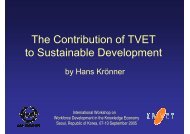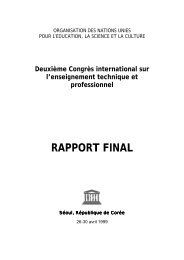Learning for Life, Work and the Future Initial ... - Unesco-Unevoc
Learning for Life, Work and the Future Initial ... - Unesco-Unevoc
Learning for Life, Work and the Future Initial ... - Unesco-Unevoc
You also want an ePaper? Increase the reach of your titles
YUMPU automatically turns print PDFs into web optimized ePapers that Google loves.
Page 42 Participants’ Papers <strong>Learning</strong> <strong>for</strong> <strong>Life</strong>, <strong>Work</strong> <strong>and</strong> <strong>the</strong> <strong>Future</strong><br />
of DACUM occupational profiles <strong>for</strong> <strong>the</strong> development<br />
of a dem<strong>and</strong>-driven, market-oriented system of occupational<br />
competence assessment <strong>and</strong> certification. The<br />
trade testing system provides an open <strong>and</strong> accessible<br />
way of assessing, recognising, accrediting <strong>and</strong> certifying<br />
job competence at different levels. It represents<br />
<strong>the</strong> only available opportunity of integrating <strong>and</strong><br />
recognising competencies acquired in <strong>the</strong> in<strong>for</strong>mal<br />
sector.<br />
The link with trade testing is designed to facilitate <strong>the</strong><br />
following:<br />
• Review of testing instruments <strong>and</strong> procedures based<br />
on occupational profiles in order to enhance <strong>the</strong>ir<br />
validity in <strong>the</strong> labour market<br />
• Re-organisation of <strong>the</strong> trade testing system in order<br />
to open it up to more occupations <strong>and</strong> c<strong>and</strong>idates.<br />
6. Conclusion<br />
The innovative experiences involved in <strong>the</strong> development<br />
of ZOSS concepts, procedures, products <strong>and</strong><br />
services are invaluable to o<strong>the</strong>r countries in <strong>the</strong> region<br />
that have already embarked or intend to embark on<br />
CBET. ZOSS is a post-modern learning organisation<br />
which is committed to sharing experiences, expertise<br />
<strong>and</strong> resources within <strong>the</strong> framework of regional integration<br />
on <strong>the</strong> introduction of CBET, with particular<br />
emphasis on <strong>the</strong> development <strong>and</strong> implementation of<br />
st<strong>and</strong>ards-based education <strong>and</strong> training based on<br />
DACUM.<br />
Abbreviations <strong>and</strong> Acronyms<br />
ACCC Association of Canadian Community Colleges<br />
CBET Competency-Based Education <strong>and</strong> Training<br />
CIDA Canadian International Development Agency<br />
CZI Confederation of Zimbabwe Industries<br />
DACUM Developing a Curriculum<br />
EMCOZ Employers Confederation of Zimbabwe<br />
GTZ German Agency <strong>for</strong> Technical Co-operation<br />
MoHET Ministry of Higher Education <strong>and</strong> Technology<br />
NAMACO National Manpower Advisory Council<br />
NVTD National Vocational Training <strong>and</strong> Development<br />
SQA Scottish Qualifications Authority<br />
ZCTU Zimbabwe Congress of Trade Unions<br />
ZIMDEF Zimbabwe Manpower Development Fund<br />
ZNCC Zimbabwe National Chamber of Commerce<br />
ZOSS Zimbabwe Occupational St<strong>and</strong>ards Services<br />
5 FOUDRAINE, Anthony (Botswana): Quality of TVET<br />
1. Introduction<br />
The need <strong>for</strong> quality in Technical <strong>and</strong> Vocational Education<br />
is in principle no different from <strong>the</strong> need <strong>for</strong><br />
quality in education in general. However, in this<br />
particular paper we want to focus on Technical<br />
Education, <strong>and</strong> we shall see that <strong>the</strong> yardstick <strong>for</strong><br />
measuring <strong>the</strong> quality is different in each type of<br />
education.<br />
In this introduction, we shall try to give a sharper<br />
description of quality when used in relation to<br />
technical education.<br />
When we compare education with an industrial process,<br />
<strong>the</strong> students 1 that enter <strong>the</strong> process can be<br />
compared with <strong>the</strong> raw material, <strong>and</strong> those that are<br />
delivered at <strong>the</strong> end can be compared with <strong>the</strong> finished<br />
product. The product may be of a high quality, getting<br />
a very positive reception in <strong>the</strong> professional periodicals,<br />
but it may not sell. The quality of a product is not<br />
enough: it must also fit <strong>the</strong> market. What is considered<br />
to be quality education in Kazakhstan is not necessarily<br />
quality education on <strong>the</strong> Fiji Isl<strong>and</strong>s. We <strong>the</strong>re<strong>for</strong>e<br />
need to define quality in TVET as <strong>the</strong> manner in which<br />
a society is willing <strong>and</strong> able to absorb <strong>the</strong> graduates of<br />
<strong>the</strong> technical education system.<br />
1 In this paper, when <strong>the</strong> male <strong>for</strong>m is used, <strong>the</strong> female <strong>for</strong>m should<br />
always apply as well<br />
2. Modes of <strong>Learning</strong><br />
2.1 Outcomes-based learning<br />
The traditional way of learning is still practised in<br />
thous<strong>and</strong>s of technical schools all over <strong>the</strong> world.<br />
Students sit in <strong>the</strong> classroom, listen to <strong>the</strong> lecturer,<br />
make notes, <strong>and</strong> prepare <strong>the</strong>mselves <strong>for</strong> examinations.<br />
In <strong>the</strong> workshops <strong>the</strong>y all make <strong>the</strong> same work-piece,<br />
<strong>and</strong> all have to be ready be<strong>for</strong>e <strong>the</strong> end of <strong>the</strong> month.<br />
Marking is ei<strong>the</strong>r on a sliding scale or in percentages,<br />
where <strong>the</strong> pass mark is usually 50%. But as soon as<br />
<strong>the</strong> student walks into his first job, he is told that <strong>the</strong><br />
work he does should be 100% correct. The outcome of<br />
his work is ei<strong>the</strong>r right or wrong.<br />
Ano<strong>the</strong>r <strong>for</strong>m of learning is <strong>the</strong> outcomes-based<br />
system. The student knows exactly what is expected of<br />
him, what is <strong>the</strong> range of <strong>the</strong> work, <strong>and</strong> what <strong>the</strong><br />
tolerances are.<br />
In technical education, this system has been introduced<br />
with varying degrees of success. It is not successful<br />
when <strong>the</strong> st<strong>and</strong>ards that are used to measure <strong>the</strong> per<strong>for</strong>mance<br />
of <strong>the</strong> students are not clearly defined, or are<br />
too high. It is impossible to expect a novice to do a job<br />
as well as a craftsman with ten years’ experience.<br />
The system can be successful when <strong>the</strong> st<strong>and</strong>ards <strong>for</strong><br />
<strong>the</strong> work, also called <strong>the</strong> criteria, are adapted to <strong>the</strong><br />
level of learning. It should also allow <strong>for</strong> an individual<br />
approach, in which <strong>the</strong> student is given <strong>the</strong> chance to





